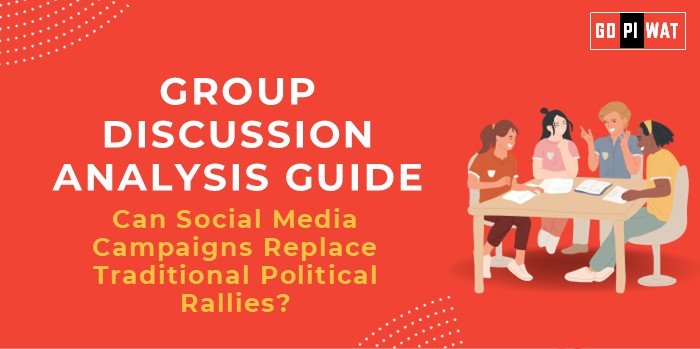📋 Group Discussion (GD) Analysis Guide: Can Social Media Campaigns Replace Traditional Political Rallies?
🌐 Introduction to the Topic
- 📖 Opening Context: Social media has emerged as a powerful political tool globally, exemplified by its influence on elections from the US to India. The shift from traditional rallies to digital engagement highlights a profound change in political campaigning.
- 💡 Topic Background: Political rallies have historically been a cornerstone of election campaigns. However, the advent of social media platforms like Twitter, Facebook, and Instagram has redefined outreach, offering cost-effective, wide-reaching alternatives.
📊 Quick Facts and Key Statistics
- 📱 India’s Social Media Users: 700+ million users, showcasing significant digital penetration (Source: IAMAI, 2024).
- 📈 Election Campaign Spending on Digital Media: 20% of political advertising budgets in 2024, a 300% increase since 2014 (Source: Media Partners Asia).
- 💸 Traditional Rally Costs: ₹5–10 crore per large rally, making social media a cost-effective option.
- 👥 Voter Influence: 60% of first-time voters consider social media platforms their primary source of political information (Source: Pew Research, 2023).
👥 Stakeholders and Their Roles
- 🏛️ Political Parties: Strategy development for digital campaigns.
- 🙋 Citizens: Engaged voters influencing and consuming content.
- 📊 Tech Platforms: Providing algorithms and analytics for targeted outreach.
- 🗳️ Election Commissions: Regulating digital advertising and content integrity.
🏆 Achievements and Challenges
✨ Achievements:
- ✅ Widespread outreach to diverse demographics.
- 📢 Real-time interaction between politicians and voters.
- 🔄 Effective crisis management and instant feedback loops.
⚠️ Challenges:
- ❌ Digital Divide: Rural and marginalized communities may be excluded.
- ⚠️ Misinformation: Fake news proliferation.
- 🛡️ Regulatory Loopholes: Campaign financing and content moderation.
Global Comparisons:
- 🇺🇸 Success: Barack Obama’s 2008 campaign pioneered social media usage.
- ❌ Challenges: Facebook’s role in the Cambridge Analytica scandal during 2016 US elections.
Case Study: Aam Aadmi Party’s 2015 Delhi campaign effectively blended rallies with social media engagement.
📄 Structured Arguments for Discussion
- 👍 Supporting Stance: “Social media democratizes political outreach, making campaigns more inclusive and accessible.”
- 👎 Opposing Stance: “Traditional rallies provide unmatched emotional and cultural connections.”
- ⚖️ Balanced Perspective: “While social media complements campaigning, it cannot wholly replace the human touch and authenticity of rallies.”
💬 Effective Discussion Approaches
- 🎯 Opening Approaches:
- 📚 Use statistics to illustrate the digital transformation in campaigns.
- 💡 Contrast the reach of a viral tweet with the turnout at a mega rally.
- 🤝 Counter-Argument Handling:
- ✅ Highlight limitations like misinformation.
- 🛡️ Address them with solutions such as stricter regulations.
🔎 Strategic Analysis of Strengths and Weaknesses
- 💪 Strengths: Cost efficiency, vast reach, and real-time feedback.
- ❌ Weaknesses: Dependence on internet penetration and credibility issues.
- 🌟 Opportunities: Harness AI for voter sentiment analysis.
- ⚠️ Threats: Cybersecurity risks and data privacy concerns.
🎓 Connecting with B-School Applications
- 🌍 Real-World Applications: Political campaign design, voter behavior analysis.
- 📝 Sample Questions:
- 💡 “How can social media help foster political inclusivity?”
- 🔍 “What are the ethical challenges of digital political advertising?”
- ✨ Insights for B-School Students:
- 📖 Explore digital marketing strategies applicable to corporate and public policy domains.


